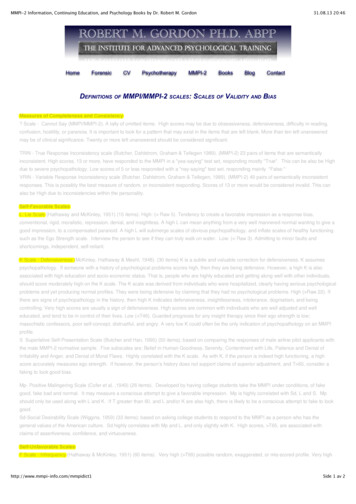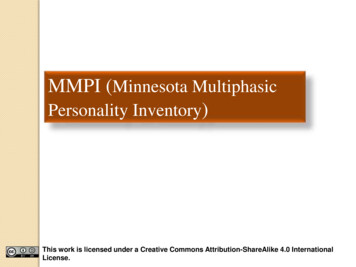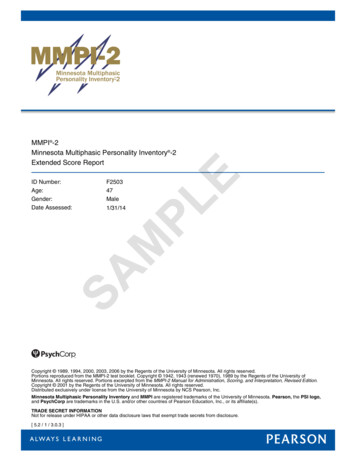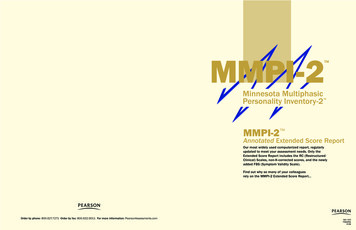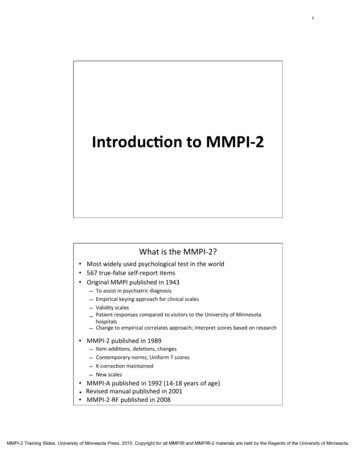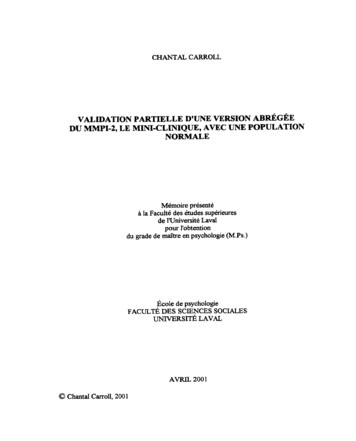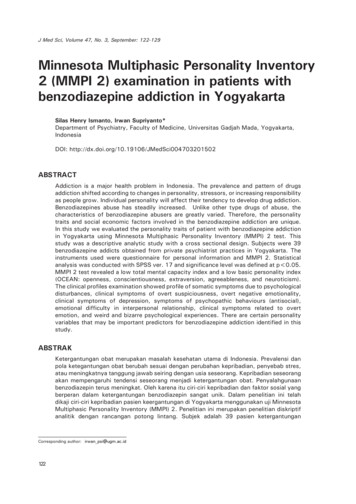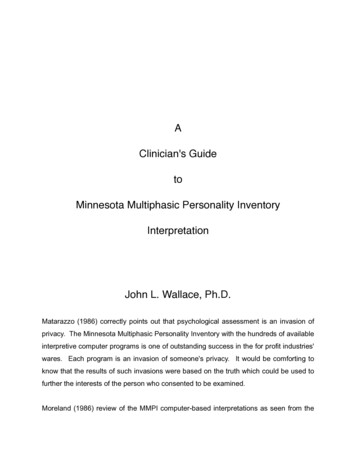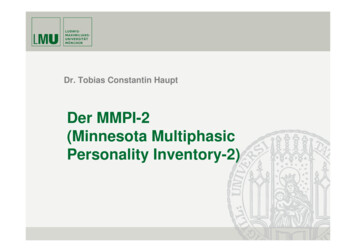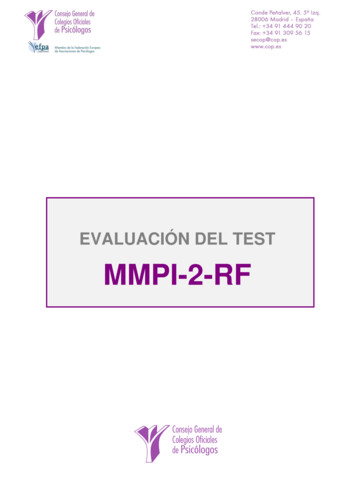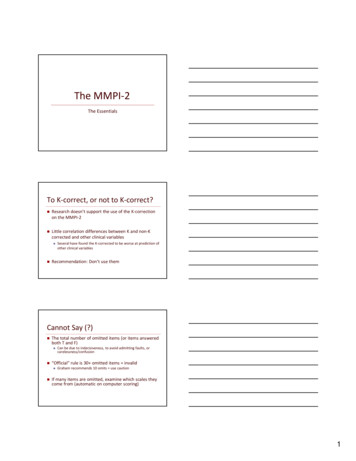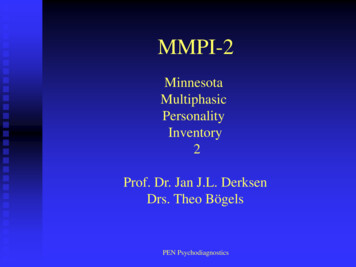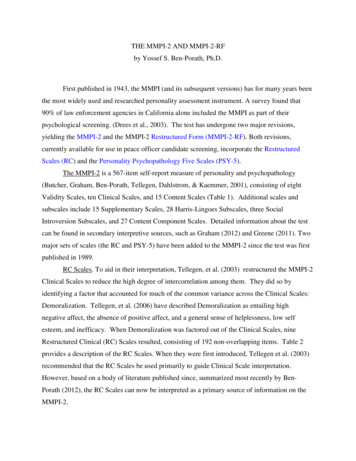
Transcription
THE MMPI-2 AND MMPI-2-RFby Yossef S. Ben-Porath, Ph.D.First published in 1943, the MMPI (and its subsequent versions) has for many years beenthe most widely used and researched personality assessment instrument. A survey found that90% of law enforcement agencies in California alone included the MMPI as part of theirpsychological screening. (Drees et al., 2003). The test has undergone two major revisions,yielding the MMPI-2 and the MMPI-2 Restructured Form (MMPI-2-RF). Both revisions,currently available for use in peace officer candidate screening, incorporate the RestructuredScales (RC) and the Personality Psychopathology Five Scales (PSY-5).The MMPI-2 is a 567-item self-report measure of personality and psychopathology(Butcher, Graham, Ben-Porath, Tellegen, Dahlstrom, & Kaemmer, 2001), consisting of eightValidity Scales, ten Clinical Scales, and 15 Content Scales (Table 1). Additional scales andsubscales include 15 Supplementary Scales, 28 Harris-Lingoes Subscales, three SocialIntroversion Subscales, and 27 Content Component Scales. Detailed information about the testcan be found in secondary interpretive sources, such as Graham (2012) and Greene (2011). Twomajor sets of scales (the RC and PSY-5) have been added to the MMPI-2 since the test was firstpublished in 1989.RC Scales. To aid in their interpretation, Tellegen, et al. (2003) restructured the MMPI-2Clinical Scales to reduce the high degree of intercorrelation among them. They did so byidentifying a factor that accounted for much of the common variance across the Clinical Scales:Demoralization. Tellegen, et al. (2006) have described Demoralization as entailing highnegative affect, the absence of positive affect, and a general sense of helplessness, low selfesteem, and inefficacy. When Demoralization was factored out of the Clinical Scales, nineRestructured Clinical (RC) Scales resulted, consisting of 192 non-overlapping items. Table 2provides a description of the RC Scales. When they were first introduced, Tellegen et al. (2003)recommended that the RC Scales be used primarily to guide Clinical Scale interpretation.However, based on a body of literature published since, summarized most recently by BenPorath (2012), the RC Scales can now be interpreted as a primary source of information on theMMPI-2.
Table 1: MMPI-2 and MMPI-2-RF ScalesMMPI-2 ScalesVALIDITY SCALESVariable Response InconsistencyTrue Response InconsistencyInfrequencyBack InfrequencyInfrequency-PsychopathologySymptom ValidityLieCorrectionSuperlativeMMPI-2-RF ScalesVRINTRINFFbFpFBSLKSVALIDITY SCALESVariable Response InconsistencyTrue Response InconsistencyInfrequent ResponsesInfrequent Psychopathology ResponsesInfrequent Somatic ResponsesSymptom ValidityResponse Bias ScaleUncommon VirtuesAdjustment ORDER SCALESEmotional/Internalizing DysfunctionThought DysfunctionBehavioral/Externalizing DysfunctionEIDTHDBXDCLINICAL c SchizophreniaHypomaniaSocial )Ma(9)Si(0)RC SCALESDemoralizationSomatic ComplaintsLow Positive EmotionsCynicismAntisocial BehaviorIdeas of PersecutionDysfunctional Negative EmotionsAberrant ExperiencesHypomanic ActivationRCdRC1RC2RC3RC4RC6RC7RC8RC9CONTENT SCALESAnxietyFearsObsessionsDepressionHealth ConcernsBizarre MentationAngerCynicismAntisocial PracticesType ALow Self-EsteemSocial DiscomfortFamily ProblemsWork InterferenceNegative Treatment RKTRTSPECIFIC PROBLEMS (SP) nterpersonal[5 scales][9 scales][4 scales][5 scales]INTEREST SCALESAesthetic-Literary InterestsMechanical-Physical InterestsAESMECPSY-5 isedPSYC-rDisconstraint-RevisedDISC-rNegative Emotionality/Neuroticism-Revised NEGE-rIntroversion/Low Positive Emotionality-RevisedINTR-r
3Table 2: MMPI-2 RC Scale DescriptionsRC SCALESRCd - DemoralizationRC1 - Somatic ComplaintsRC2 - Low Positive EmotionsGeneral dissatisfaction, unhappiness, hopelessness,self-doubt, inefficacySelf-reported neurological, gastro-intestinal, andpain-related complaintsLack, of or incapacity to experience positiveemotions; Core vulnerability factor for depressionRC3 - CynicismNon-self-referential belief in human badnessRC4 - Antisocial BehaviorIncluding, juvenile misconduct, family problems,substance misuseRC6 – Ideas of PersecutionSelf-referential persecutory ideationRC7 - Dysfunctional Negative EmotionsIncluding, anxiety, irritability, anger, over-sensitivity,vulnerabilityRC8 - Aberrant ExperiencesUnusual perceptual and thought processesRC9 - Hypomanic ActivationImpulsivity, grandiosity, aggression, and generalizedactivationPSY-5 Scales. The MMPI-2 Personality Psychopathology-Five scales (PSY-5) weredeveloped to assess dimensions of personality similar, but not identical to the “Big Five”personality traits of Neuroticism, Extraversion, Agreeableness, Conscientiousness, andOpenness (Harkness, McNultry & Ben-Porath, 1995). A description of the PSY-5 scales isprovided in Table 3. The PSY-5 scales differ from the “Big Five” in that they target a moredysfunctional range of personality functioning.The MMPI-2-RF consists of a subset of 338 items from the MMPI-2. It includesnine Validity Scales (seven of which are modified versions of the MMPI-2 Validity Scales).Also included are the nine RC Scales (identical in composition to the ones scored on theMMPI-2) and PSY-5 Scales (revised to be scored from the reduced item pool). The MMPI2-RF also includes: (a) three Higher-Order Scales that assess three broad domains ofdysfunction measured by the MMPI-2 item pool: Emotional/Internalizing Dysfunction,Thought Dysfunction, and Behavioral/Externalizing Dysfunction, (b) 23 Specific ProblemsScales, covering the areas of somatic complaints, internalizing problems, externalizingproblems, and interpersonal difficulties, and (c) two Interest Scales. Detailed informationabout the scales of the MMPI-2-RF can be found in two test manuals: Manual forAdministration, Scoring, and Interpretation (Ben-Porath & Tellegen, 2008/2011), andTechnical Manual (Tellegen & Ben-Porath, 2008/2011).
Table 3: MMPI-2 PSY-5 Scale DescriptionsPSY-5 SCALESAggressiveness (AGGR-r) Offensive, instrumental aggression Enjoy intimidating others More likely to have history of being physically abusivePsychoticism (PSYC-r) Disconnection from reality Unusual sensory/perceptual experiences Alienation Unrealistic expectations of harmDisconstraint (DISC-r) Risk-taking, impulsive behavior AntisocialNegative Emotionality/Neuroticism (NEGE-r) Anxious, worry-prone Focus on the negative Overly Self-criticalIntroversion/Low Positive Emotionality (INTR-r) Social withdrawal Poor hedonic capacityUsing modern scale construction techniques, the MMPI-2-RF Scales were designed tomeasure the constructs assessed by the MMPI-2 in a more efficient and psychometrically soundmanner. They include measures of distinctive Clinical Scale components that are not represented inthe RC Scales, measures of facets of the RC Scales that warrant separate assessment (for example, asubstance abuse facet of RC4), as well as scales designed to assess clinically significant attributesthat are not directly assessed by Clinical or RC Scales. The three Higher-Order Scales serve the dualrole of measuring broad-based dimensions of personality and psychopathology and providing anorganizing framework for interpreting MMPI-2-RF scale scores.Many of the MMPI-2-RF scales are linked empirically and conceptually to currentmodels and concepts of personality and psychopathology (Ben-Porath, 2012). Because the 338items are a subset of the 567 items of the MMPI-2, it is possible to use existing MMPI-2 datasets to investigate the MMPI-2-RF. The Technical Manual for the MMPI-2-RF includesdescriptive data for all scales in a law enforcement candidate sample collected in California.Pre vs. Post-Offer. Since they provide a measure of psychopathology as well aspersonality, the MMPI-2 and MMPI-2-RF are considered “medical” examinations under theAmericans with Disabilities Act, and therefore cannot lawfully be administered prior to a
5conditional offer of employment, regardless of the manner in which the responses are interpreted(Karraker v. Rent-A-Center, Inc., 2006).Developmental Sample. The general normative sample for the MMPI-2 consists of 1138men and 1462 women. Comparisons with the 1990 census indicate that the MMPI-2 normativesample generally matches the demographics of the adult population of the United States (Butcheret al., 2001). Although the MMPI-2 normative sample has a higher education level, arecalculation of MMPI-2 norms based on a census-matched normative subsample did not resultin an appreciable change in scores (Schinka and LaLone, 1997). Thus, the normative sample forthe MMPI-2 (and MMPI-2-RF, which is based on the same 1138 men and a subset of 1138women) yields standard T-scores that allow comparison of an individual’s scores with arepresentative sample of the general population of the United States.Gender-Based Differences. Historically, MMPI-2 protocols were interpreted bycomparing a test-taker’s responses to the normative sample for his/her own gender (e.g., a male’sresponses were compared to the 1138 men in the normative sample). However, the use ofgender-based norms in employment-related assessments was prohibited by the 1991 U.S. CivilRights Act. Non-gendered norms were subsequently developed (Ben-Porath & Forbey, 2003)and incorporated in the MMPI-2 materials. Non-gendered T-score conversion tables were createdby randomly selecting 1138 women from the MMPI-2 normative sample, merging their data withthose of the 1138 men in the sample, and recalculating the standard T scores for all MMPI-2scales. The standard T-scores for the MMPI-2-RF are based on the same non-genderednormative sample of 2276 individuals; there are no gender-specific norms for the revisedinstrument.Non-gendered norms have been found to be largely the same as gendered norms; ingeneral, no more than 5 T-score point differences (roughly equivalent to the standard error ofmeasurement) separate the average gendered scale scores of men and women when comparedwith their non-gendered scores (Forbey & Ben-Porath, 2003). Two exceptions include theContent Scale “Fears,” in which the scores of men are somewhat lower than women, and scoreson PSY-5 Scale “Disconstraint,” on which women score somewhat lower than men.Ethnic Differences/Adverse Impact. Adverse impact occurs when selection decisions aremade on the basis of pre-set cutoffs that result in substantially different proportions of groupmembers (e.g., race, gender) being rejected. Since the findings from the MMPI-2 or MMPI-2-RF
6should be integrated with the results of other tests and a clinical interview in making such adetermination, the MMPI-2 instrument alone should not result in adverse impact. Nevertheless,evaluators should be aware of the role that cultural and demographic factors may play inpsychological test results.Extensive research has also been conducted on use of the MMPI-2 with different cultural,racial and ethnic groups within the United States. Much of this research has focused oncomparisons of African Americans and Caucasians. Such studies have yielded some significantdifferences in mean scores across these two groups, often attributed to real cultural and socioeconomic factors (for example on the Content Scale “Cynicism”). However, the few studies thathave compared validity coefficients of the MMPI-2 across racial groups (e.g., Arbisi, BenPorath, & McNulty, 2003; McNulty, Graham, Ben-Porath, & Stein, 1997) have not produced anyevidence of meaningful slope or intercept bias when comparing the predictive validity of the testin African Americans and Caucasians.With the growth in the size of the Hispanic/Latino population in the United States,greater attention has been paid in the literature to the use of the test with this population.Garrido and Velasquez (2006) summarized the literature in this area and offer specificrecommendations for the culturally competent use of the MMPI-2 in interpreting test scores ofHispanics/Latinos assessed in the United States. For example, these authors recommend carefulconsideration of the test-taker’s English-language proficiency if the test is administered inEnglish and weighing the cultural adaptation of Hispanic/Latino immigrants and their offspring.Overall, ample empirical evidence indicates that the MMPI-2 can be used effectivelyacross a wide range of nationalities, languages, cultures, and racial/ethnic groups. Because theMMPI-2-RF is based upon a subset of the MMPI-2 item pool and essentially the same set ofnorms, it can be assumed that any differences based on ethnicity would mirror those found forthe MMPI-2.Reading Level. The MMPI-2 manual recommends that test-takers have at least a sixthgrade reading level. This recommendation was made on the basis of an analysis of thereadability of the individual test items. Schinka and Borum (1993) concluded that the MMPI-2item pool can be read at the fourth to fifth grade level. In the most extensive item-by-itemanalysis of the readability of individual MMPI-2 items conducted to date, Dahlstrom, Archer,Hopkins, Jackson and Dahlstrom (1999) found that 90% of the MMPI-2 items had a fifth grade
7reading level. When the entire item pool is analyzed, rather than each item individually, theMMPI-2 item pool yields a Flesh-Kincaid Index of 4.6 and the MMPI-2-RF item pool yields aFlesch-Kincaid index of 4.5 (Ben-Porath & Tellegen, 2008/2011).PSYCHOMETRICSReliability and Standard Error of Measurement. The MMPI-2 and MMPI-2-RF manualsprovide data on the reliability and the standard errors of measurement associated with scalescores on these tests. The test-retest reliability analyses
THE MMPI-2 AND MMPI-2-RF by Yossef S. Ben-Porath, Ph.D. First published in 1943, the MMPI (and its subsequent versions) has for many years been the most widely used and researched personality assessment instrument. A survey found that 90% of law enforcement agencies in California alone included the MMPI as part of their psychological screening. (Drees et al., 2003). The test has
